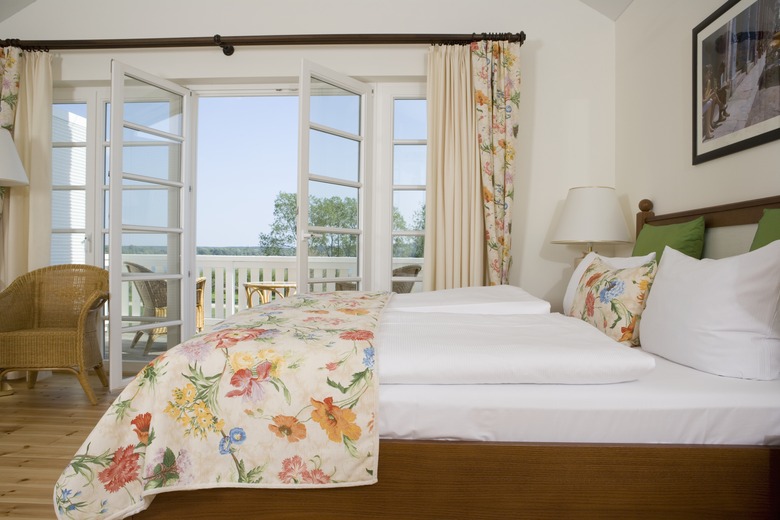How To Hang Curtains On French Doors Without Drilling Holes In Doors
We may receive a commission on purchases made from links.
As satisfying as decorating a living space can be, there may come a moment when you have to decide whether to drive nails and drill holes into special doors and freshly painted walls — and who isn't reluctant to proceed with that? For example, how can you hang curtains on your French doors without drilling for brackets? Is there possibly a way to avoid marring something so you can avoid the regret you'd feel if you took the curtains down for redecorating?
It depends. Curtains are normally seen only on traditional wood French doors, but those are a no-go for the no-drill. If you have steel exterior French doors, however, or if you can think outside the box when it comes to design concepts, there are approaches that allow your drill to stay snug on its hook in the garage.
About French Doors
About French Doors
For either exterior or interior use, French doors have glass running top to bottom within the frame. The glass pane, also called the "light," is often divided into smaller panes by a grille. First used in 17th-century France long before electricity, they offer a stylish way to bring more light into a room while increasing a sense of openness and spaciousness.
French doors are traditionally made in hinged pairs that meet and latch in the middle, but they are also made as telescoping doors, sliding pocket doors, and single doors with a stationary panel on the side. They're made from vinyl, aluminum, fiberglass, steel, and wood, which is the material most commonly used.
Hanging French Door Curtains
Hanging French Door Curtains
You can hang curtains over the frame around a French door just as you'd hang drapes over a window frame: with brackets holding a rod for curtains that can either be pushed aside or tied back to clear the door swing, allowing passage.
Curtains that hang not over but actually on the French doors, however, are most often seen on interior traditional-design wood French doors and are sometimes cinched in the middle with a tie sash that converts the curtain to an hourglass shape. They're normally mounted on rod-and-bracket setups at the top of the glass and at the bottom, securing them so they don't swing free — all of which requires drilling.
The only way to hang this type of traditional French door curtain without putting holes in the wood involves purchasing curtain rod hooks with adhesive backing or self-sticking cafe rod brackets. Just keep in mind that you may pull off some of the painted surface if you remove a hook or bracket and that there are product-performance limits necessitating the use of very lightweight curtains, such as sheers.
Another option is to use a magnetic curtain rod. Available in different finishes with various styles of finials and backplates, they only work on steel doors, which are usually exterior. Interior steel French doors are being seen with greater frequency but are super contemporary, often used with industrial-look design, and are not the sort of doors that pair well with gathered sheer curtains.
If your French doors have one window undivided by grilles into multiple panes and if the profile of the frame next to the glass is contoured with a flat portion that's deep enough, you can use tension rods at the top and bottom to hold your curtains. However, such door design would be the exception to the rule for most traditional doors, whose glass is normally framed in quarter round, but it's a solution to the no-holes problem in rare cases.
Consider a Portiere
Consider a Portiere
If you can't find a suitable method for hanging top- and bottom-secured curtains over the glass in your French doors, try a twist on the Victorian-style portiere to get around drilling into the wood. Portieres were hung with rods over the door frame. Often of very heavy fabrics, they usually tied back, had swag valances running between them, and frequently displayed fringe trims. If you do a contemporary version of this, you have to make sure that the curtains don't interfere with the swing of the door.
